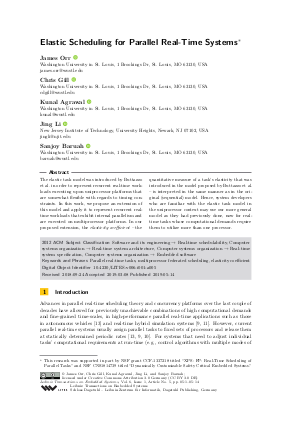Elastic Scheduling for Parallel Real-Time Systems
Authors
James Orr  ,
Chris Gill
,
Chris Gill  ,
Kunal Agrawal
,
Kunal Agrawal  ,
Jing Li
,
Jing Li  ,
Sanjoy Baruah
,
Sanjoy Baruah 
-
Part of:
Issue:
LITES, Volume 6, Issue 1
Part of: Volume: LITES, Volume 6
Part of: Journal: Leibniz Transactions on Embedded Systems (LITES) - License:
 Creative Commons Attribution 3.0 Germany license
Creative Commons Attribution 3.0 Germany license
- Publication Date: 2019-05-14
File

PDF
LITES-v006-i001-a005.pdf
- Filesize: 0.54 MB
- 14 pages
Document Identifiers
Subject Classification
ACM Subject Classification
- Software and its engineering → Real-time schedulability
- Computer systems organization → Real-time system architecture
- Computer systems organization → Real-time system specification
- Computer systems organization → Embedded software
Keywords
- Parallel real-time tasks
- multiprocessor federated scheduling
- elasticity coefficient
Metrics
- Access Statistics
-
Total Accesses (updated on a weekly basis)
0Document
0Metadata
Abstract
The elastic task model was introduced by Buttazzo et al.~in order to represent recurrent real-time workloads executing upon uniprocessor platforms that are somewhat flexible with regards to timing constraints. In this work, we propose an extension of this model and apply it to represent recurrent real-time workloads that exhibit internal parallelism and are executed on multiprocessor platforms. In our proposed extension, the elasticity coefficient - the quantitative measure of a task's elasticity that was introduced in the model proposed by Buttazzo et al. - is interpreted in the same manner as in the original (sequential) model. Hence, system developers who are familiar with the elastic task model in the uniprocessor context may use our more general model as they had previously done, now for real-time tasks whose computational demands require them to utilize more than one processor.
Cite As Get BibTex
James Orr, Chris Gill, Kunal Agrawal, Jing Li, and Sanjoy Baruah. Elastic Scheduling for Parallel Real-Time Systems. In LITES, Volume 6, Issue 1 (2019). Leibniz Transactions on Embedded Systems, Volume 6, Issue 1, pp. 05:1-05:14, Schloss Dagstuhl – Leibniz-Zentrum für Informatik (2019)
https://doi.org/10.4230/LITES-v006-i001-a005
BibTex
@Article{orr_et_al:LITES-v006-i001-a005,
author = {Orr, James and Gill, Chris and Agrawal, Kunal and Li, Jing and Baruah, Sanjoy},
title = {{Elastic Scheduling for Parallel Real-Time Systems}},
journal = {Leibniz Transactions on Embedded Systems},
pages = {05:1--05:14},
ISSN = {2199-2002},
year = {2019},
volume = {6},
number = {1},
publisher = {Schloss Dagstuhl -- Leibniz-Zentrum f{\"u}r Informatik},
address = {Dagstuhl, Germany},
URL = {https://drops.dagstuhl.de/entities/document/10.4230/LITES-v006-i001-a005},
URN = {urn:nbn:de:0030-drops-192819},
doi = {10.4230/LITES-v006-i001-a005},
annote = {Keywords: Parallel real-time tasks, multiprocessor federated scheduling, elasticity coefficient}
}
Author Details
References
- P. Antsaklis and J. Baillieul.Guest Editorial Special Issue on Networked Control Systems. IEEE Transactions on Automatic Control, 49(9):1421-1423, September 2004. URL: http://dx.doi.org/10.1109/TAC.2004.835210
-
Sanjoy Baruah, Vincenzo Bonifaci, Alberto Marchetti-Spaccamela, Leem Stougie, and Andreas Wiese.A generalized parallel task model for recurrent real-time processes. In Proceedings of the IEEE Real-Time Systems Symposium, RTSS 2012, pages 63-72, San Juan, Puerto Rico, 2012.

-
Giorgio Buttazzo, Enrico Bini, and Darren Buttle.Rate-Adaptive Tasks: Model, Analysis, and Design Issuess. In Proceedings of DATE 2014: Design, Automation and Test in Europe, March 2014.

-
Giorgio C. Buttazzo, Giuseppe Lipari, and Luca Abeni.Elastic Task Model for Adaptive Rate Control. In 1998 IEEE Real-Time Systems Symposium (RTSS), 1998.

- Giorgio C. Buttazzo, Giuseppe Lipari, Marco Caccamo, and Luca Abeni.Elastic Scheduling for Flexible Workload Management. IEEE Trans. Comput., 51(3):289-302, March 2002. URL: http://dx.doi.org/10.1109/12.990127
- M. Caccamo, G. Buttazzo, and Lui Sha.Elastic feedback control. In Proceedings 12th Euromicro Conference on Real-Time Systems. Euromicro RTS 2000, pages 121-128, 2000. URL: http://dx.doi.org/10.1109/EMRTS.2000.853999
-
T. Chantem, X. S. Hu, and M. D. Lemmon.Generalized Elastic Scheduling. In 2006 27th IEEE International Real-Time Systems Symposium (RTSS'06), pages 236-245, 2006.

- T. Chantem, X. S. Hu, and M. D. Lemmon.Generalized Elastic Scheduling for Real-Time Tasks. IEEE Transactions on Computers, 58(4):480-495, April 2009. URL: http://dx.doi.org/10.1109/TC.2008.175
- D. Ferry, G. Bunting, A. Maqhareh, A. Prakash, S. Dyke, K. Aqrawal, C. Gill, and C. Lu.Real-time system support for hybrid structural simulation. In 2014 International Conference on Embedded Software (EMSOFT), pages 1-10, October 2014. URL: http://dx.doi.org/10.1145/2656045.2656067
- David Ferry, Jing Li, Mahesh Mahadevan, Kunal Agrawal, Christopher Gill, and Chenyang Lu.A Real-time Scheduling Service for Parallel Tasks. In Proceedings of the 2013 IEEE 19th Real-Time and Embedded Technology and Applications Symposium (RTAS), RTAS '13, pages 261-272, Washington, DC, USA, 2013. IEEE Computer Society. URL: http://dx.doi.org/10.1109/RTAS.2013.6531098
-
David Ferry, Amin Maghareh, Gregory Bunting, Arun Prakash, Kunal Agrawal, Chris Gill, Chenyang Lu, and Shirley Dyke.On the performance of a highly parallelizable concurrency platform for real-time hybrid simulation. In The Sixth World Conference on Structural Control and Monitoring, 2014.

-
R. Graham.Bounds on multiprocessor timing anomalies.SIAM Journal on Applied Mathematics, 17:416-429, 1969.

-
J. Kim, H. Kim, K. Lakshmanan, and R. Rajkumar.Parallel scheduling for cyber-physical systems: Analysis and case study on a self-driving car. In 2013 ACM/IEEE International Conference on Cyber-Physical Systems (ICCPS), pages 31-40, April 2013.

-
Jing Li, Abusayeed Saifullah, Kunal Agrawal, Christopher Gill, and Chenyang Lu.Analysis Of Federated And Global Scheduling For Parallel Real-Time Tasks. In Proceedings of the 2012 26th Euromicro Conference on Real-Time Systems, ECRTS '14, Madrid (Spain), 2014. IEEE Computer Society Press.

-
C. Liu and J. Layland.Scheduling Algorithms for Multiprogramming in a Hard Real-Time Environment. Journal of the ACM, 20(1):46-61, 1973.

-
J. Ullman.NP-complete scheduling problems. Journal of Computer and System Sciences, 10(3):384-393, 1975.

